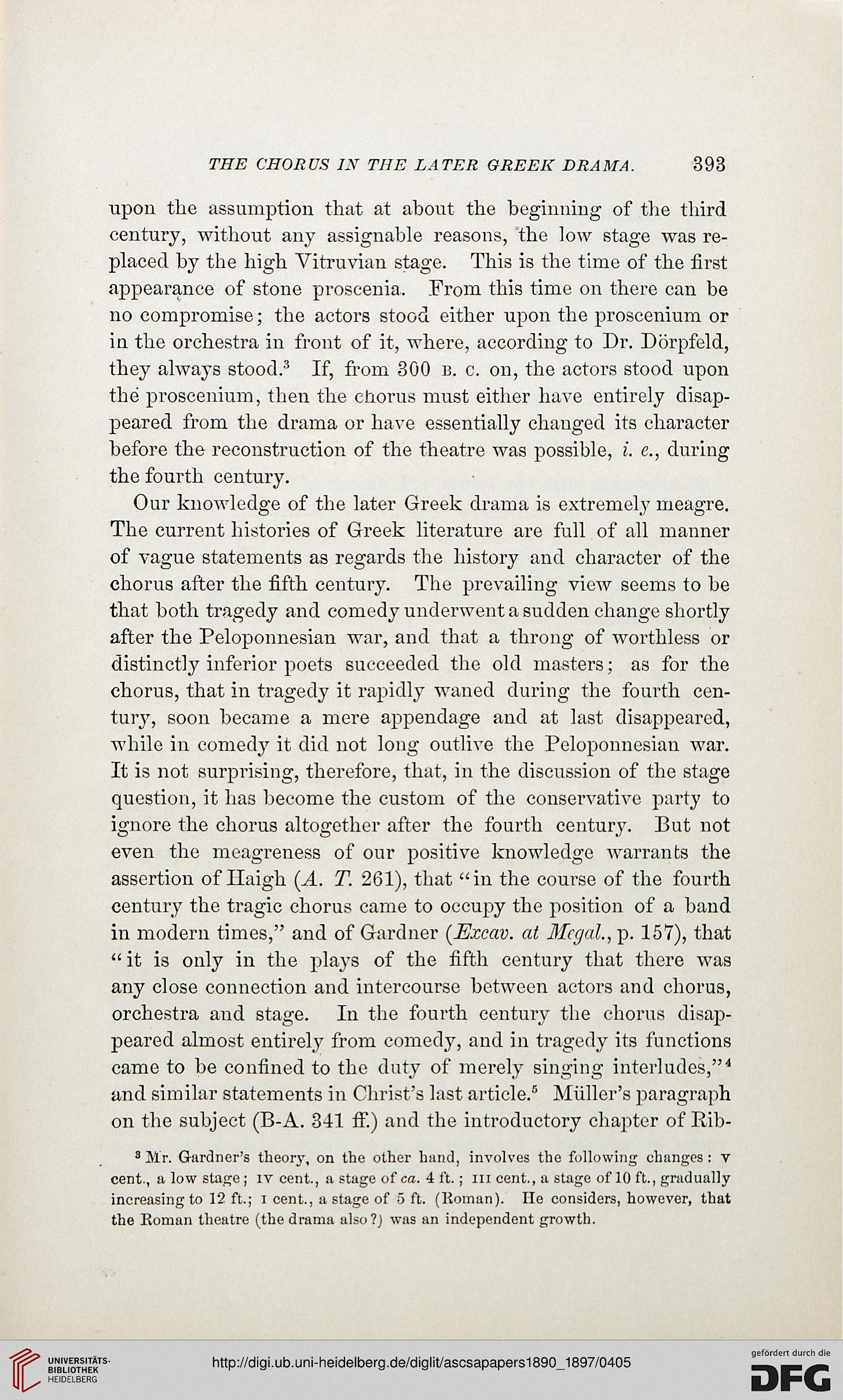THE CHORUS IN THE LATER GREEK DRAMA.
393
upon the assumption that at about the beginning of the third
century, without any assignable reasons, the low stage was re-
placed by the high Vitruvian stage. This is the time of the first
appearance of stone proscenia. From this time on there can be
no compromise; the actors stood either upon the proscenium or
in the orchestra in front of it, where, according to Dr. Dorpfeld,
they always stood.3 If, from 300 is. c. on, the actors stood upon
the proscenium, then the chorus must either have entirely disap-
peared from the drama or have essentially changed its character
before the reconstruction of the theatre was possible, l. e., during
the fourth century.
Our knowledge of the later Greek drama is extremely meagre.
The current histories of Greek literature are full of all manner
of vague statements as regards the history and character of the
chorus after the fifth century. The prevailing view seems to be
that both tragedy and comedy underwent a sudden change shortly
after the Peloponnesian war, and that a throng of worthless or
distinctly inferior poets succeeded the old masters; as for the
chorus, that in tragedy it rapidly waned during the fourth cen-
tury, soon became a mere appendage and at last disappeared,
while in comedy it did not long outlive the Peloponnesian war.
It is not surprising, therefore, that, in the discussion of the stage
question, it has become the custom of the conservative party to
ignore the chorus altogether after the fourth century. But not
even the meagreness of our positive knowledge warrants the
assertion of Haigh (A. T. 261), that "in the course of the fourth
century the tragic chorus came to occupy the position of a band
in modern times," and of Gardner (Excav. at Megal., p. 157), that
" it is only in the plays of the fifth century that there was
any close connection and intercourse between actors and chorus,
orchestra and stage. In the fourth century the chorus disap-
peared almost entirely from comedy, and in tragedy its functions
came to be confined to the duty of merely singing interludes,"4
and similar statements in Christ's last article.5 Miiller's paragraph
on the subject (B-A. 341 fF.) and the introductory chapter of Rib-
3 Mr. Gardner's theory, on the other hand, involves the following changes: v
cent., a low stage; iv cent., a stage of ca. 4 ft.; in cent., a stage of 10 ft., gradually
increasing to 12 ft.; I cent., a stage of 5 ft. (lloman). He considers, however, that
the Roman theatre (the drama also?) was an independent growth.
393
upon the assumption that at about the beginning of the third
century, without any assignable reasons, the low stage was re-
placed by the high Vitruvian stage. This is the time of the first
appearance of stone proscenia. From this time on there can be
no compromise; the actors stood either upon the proscenium or
in the orchestra in front of it, where, according to Dr. Dorpfeld,
they always stood.3 If, from 300 is. c. on, the actors stood upon
the proscenium, then the chorus must either have entirely disap-
peared from the drama or have essentially changed its character
before the reconstruction of the theatre was possible, l. e., during
the fourth century.
Our knowledge of the later Greek drama is extremely meagre.
The current histories of Greek literature are full of all manner
of vague statements as regards the history and character of the
chorus after the fifth century. The prevailing view seems to be
that both tragedy and comedy underwent a sudden change shortly
after the Peloponnesian war, and that a throng of worthless or
distinctly inferior poets succeeded the old masters; as for the
chorus, that in tragedy it rapidly waned during the fourth cen-
tury, soon became a mere appendage and at last disappeared,
while in comedy it did not long outlive the Peloponnesian war.
It is not surprising, therefore, that, in the discussion of the stage
question, it has become the custom of the conservative party to
ignore the chorus altogether after the fourth century. But not
even the meagreness of our positive knowledge warrants the
assertion of Haigh (A. T. 261), that "in the course of the fourth
century the tragic chorus came to occupy the position of a band
in modern times," and of Gardner (Excav. at Megal., p. 157), that
" it is only in the plays of the fifth century that there was
any close connection and intercourse between actors and chorus,
orchestra and stage. In the fourth century the chorus disap-
peared almost entirely from comedy, and in tragedy its functions
came to be confined to the duty of merely singing interludes,"4
and similar statements in Christ's last article.5 Miiller's paragraph
on the subject (B-A. 341 fF.) and the introductory chapter of Rib-
3 Mr. Gardner's theory, on the other hand, involves the following changes: v
cent., a low stage; iv cent., a stage of ca. 4 ft.; in cent., a stage of 10 ft., gradually
increasing to 12 ft.; I cent., a stage of 5 ft. (lloman). He considers, however, that
the Roman theatre (the drama also?) was an independent growth.





